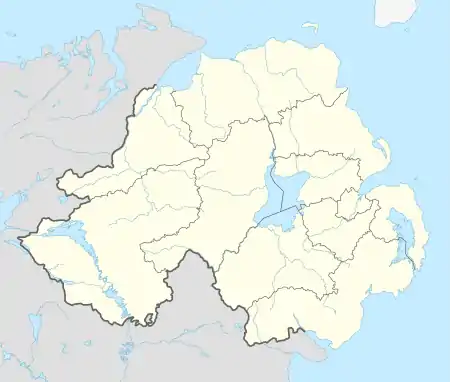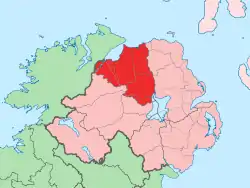Portstewart
Portstewart (Irish: Port Stíobhaird) is a small town in County Londonderry, Northern Ireland. It had a population of 8,003 people in the 2011 Census.[2] It is a seaside resort neighbouring Portrush. Its harbour and scenic coastal paths form an Atlantic promenade leading to a two-miles beach (Portstewart Strand), popular with holidaymakers in summer and surfers year-round.
| Portstewart | |
|---|---|
 | |
 Portstewart Location within Northern Ireland | |
| Population | 8,003 (2011 Census) |
| District | |
| County | |
| Country | Northern Ireland |
| Sovereign state | United Kingdom |
| Post town | PORTSTEWART |
| Postcode district | BT55 |
| Dialling code | 028 |
| Police | Northern Ireland |
| Fire | Northern Ireland |
| Ambulance | Northern Ireland |
| UK Parliament | |
| NI Assembly | |
Profile
Portstewart was a popular holiday destination for Victorian middle-class families. Its long, crescent-shaped seafront promenade is sheltered by rocky headlands. It is a reasonably prosperous town. Most of the town is contained in the Strand electoral ward and this is one of the most affluent areas in Northern Ireland. In a deprivation index of electoral wards in Northern Ireland the Strand Ward in the town was ranked 570th out of the 582 wards.[3]
House prices in Portstewart have been amongst the highest in Northern Ireland. According to the University of Ulster Quarterly House Price Index report produced in partnership with Bank of Ireland and the Northern Ireland Housing Executive in Q4 2010, the North Coast region (Coleraine/Limavady area) had higher property prices than those of affluent south Belfast.[4]
Due to unusually high second home ownership there has been concern in recent years about the pace of development in the town. The number of holiday houses or apartments being purchased has led to rapid inflation of house prices. The town has also houses many of the students from the nearby Coleraine Campus of the University of Ulster and has a vibrant social and cultural life.
Portstewart is one of the most integrated towns in Northern Ireland with the religious demographics similar to the population of Northern Ireland as a whole. Community relations are generally good within the town. Dominican College, a Catholic grammar school, has a significant proportion of Protestant students and staff.
History

Portstewart was founded in 1792 by John Cromie, who named it after his maternal ancestors, the Stewarts of Ballylesse.[5] A Lieutenant Stewart is said to have obtained a lease of land from The 5th Earl of Antrim (first creation; 1713-1775) in 1734.[6] Prior to this, the area was formerly called in Irish: Port na Binne Uaine, a name related to the nearby island and townland of Benoney (an anglicisation of Binne Uaine).[1] The name Port na Binne Uaine is still used today alongside the Gaelicised version Port Stíobhaird.[7]
As recently as the mid 18th century Portstewart was little more than a fishing village, although it has been inhabited since the Neolithic era. Portstewart developed to a modest size seaside resort in the mid 19th century under the influence of a local landlord, John Cromie. Its development and character was influenced greatly by the Sabbatarian sensitivities of the Cromies and the consequent resistance to a railway connection in the mid 19th century. The scale of development for the next century was more modest than that of neighbouring Portrush which rapidly expanded (particularly in the late Victorian era) with the mass tourism market. Despite a tram connection being provided from Portstewart to Cromore to link with the railway, the town developed with a more genteel character. With the ascent of the car as the predominant means of travel through the 20th century, Portstewart developed a wider role as a popular holiday and recreational destination, along with a significant dormitory function due to its proximity to Coleraine as well as being a local service centre.
From the 1950s until into the 1980s the town's main development thrust was as a residential area, with the steady construction of new dwellings in the suburbs mainly for owner occupation. Unlike Portrush where there was a rapid expansion of static caravan parks, Portstewart continued to avoid the effects of mass tourism.
Over the past 15 years however, there has been a widespread perception that the character of the town has changed through the rapid growth of the student population and the accelerating expansion of second home ownership.
Places of interest
- Portstewart has a Dominican convent (an imposing Gothic mansion) with the attached Dominican College sitting on the edge of a cliff which dominates the western end of the Promenade. The site, formally known as "O'Hara's Castle" was built in 1834 and bought by the Dominican order in 1917 to be a centre of education in the north west of Ireland.[8]
The eastern end of the Promenade has a small harbour which has recently undergone refurbishment.

- Just west of the town stretches Portstewart Strand, a clean two-mile long blue flag beach, protected by the National Trust. Portstewart Strand has been popular with holiday-makers for generations. Saint Patrick's well is to be found at the head of the strand, which was used in the 19th century and early 20th century for horse racing. The beach finishes at the Barmouth of the River Bann overlooking Castlerock.
- Beneath the convent is a cliff path which stretches along the coast from the Promenade to Portstewart Strand. From here it is a popular walk to the Barmouth, where the Bann flows out into the Atlantic Ocean. The cliff path has panoramic views across the Strand and Downhill with Donegal in the background. The Barmouth is a sanctuary for waders, wildfowl and nesting birds. Beyond the Barmouth lies Castlerock, Mussenden Temple, Benone Strand and the Magilligan Strand.
- In one of the caves beneath the cliff path there is reputed to be a secret passage leading to O'Hara's Castle, now the Dominican Convent. No actual evidence of this passage has been found.
- To the east of Portstewart is a popular walking/cycling path along the coast to Portrush, leading to the Giants Causeway (a UNESCO World Heritage Site), Carrick-a-Rede Rope Bridge and the Old Bushmills Distillery (the oldest licensed distillery in the world).
- The North Antrim Coast Path, part of the Ulster Way, starts at Portstewart Strand and continues for 40 miles along the coast to Murlough Bay.
Transport
The nearest stations are Portrush and Coleraine with Northern Ireland Railways providing connections west to Castlerock and Londonderry railway station and east to Belfast Lanyon Place railway station and Belfast Great Victoria Street railway station. Ulsterbus provide connections to the trains at Coleraine railway station.
Sport
- The town is home to three golf courses (under one club – Portstewart Golf Club), made lively by the forceful Atlantic wind. Portstewart has one of the few 54-hole complexes in Europe. The championship links Strand course is set amidst imposing sand dunes with panoramic views across the Atlantic mouth of Lough Foyle to the Inishowen peninsula beyond. The Strand Course hosted the Dubai Duty Free Irish Open in 2017 for the first time in the club's history and was the biggest event staged in the town ever attracting crowds of 92,000+.
- Portstewart F.C. are an intermediate football club playing in the NIFL Premier Intermediate League.
- Every May, the North West 200 motorcycle race passes through the town, with the starting grid and pit area on the coastal road between Portrush and Portstewart. The circuit between the towns of Portrush, Portstewart and Coleraine is one of the fastest in the world, with top speeds exceeding 200 mph on public roads. It is one of the last such classic races held in Europe. Drawing crowds of over 150,000, it is the largest outdoor sporting event in Ireland.[9]
- CLG Eoghan Rua, Coleraine, is the local Gaelic Athletic Association club and the playing grounds are just outside Portstewart.
- Portstewart also hosts matches in the Super Cup NI.
- Portstewart Eagles Baseball team
People
- The songwriter Jimmy Kennedy was inspired by one of the town's sunsets when he wrote "Red Sails in the Sunset". Jimmy Kennedy was born in Omagh but grew up in Portstewart. Since the early 2000s the town has an annual Red Sails Festival each July, which culminates with a firework display over the bay. The Portstewart Community Association website promotes the festival.
- Briana Corrigan was vocalist with The Beautiful South and the lead female vocalist on a number one single in 1990, "A Little Time". She grew up in Portstewart and attended the Dominican College.
- Jimeoin (McKeown), the successful comedian is also a former resident of Portstewart having attended Dominican College before finding fame with his unique comic style first in Australia and then internationally.
- Harry Gregg, the former Northern Ireland footballer, used to own a hotel in the town.
- Billy Leonard, Sinn Féin politician and former member of the Northern Ireland Assembly lives in Portstewart
- Harry Mullan (1946–1999), acknowledged as one of the world's leading boxing writers.
- Sean Farren, Social Democratic and Labour Party politician and former member of the Northern Ireland Assembly, lives in Portstewart.
- Henry McCullough, guitarist. McCullough began his career with The Skyrockets, followed by Gene and The Gents, (both were Showbands from Enniskillen). He was then part of Paul McCartney's group Wings, before moving on to other groups. He was resident back Portstewart, until his death in 2016. He had been unwell for some time. He is the only Northern Irishman to have played at Woodstock, having backed Joe Cocker.
- Field Marshal Sir George White, VC, who commanded the garrison at the Siege of Ladysmith during the Second Boer War, was born at Low Rock Castle.
Demography
On Census day (27 March 2011) there were 8,003 people living in Portstewart (3,338 households), accounting for 0.44% of the NI total.[2] The Census 2011 population represented an increase of 2.6% on the Census 2001 figure of 7,803.[10] Of the Census 2011 population:
- 14.77% were aged under 16 years and 18.94% were aged 65 and over;
- 52.73% of the usually resident population were female and 47.27% were male;
- 56.98% belong to or were brought up in a 'Protestant and Other Christian (including Christian related)'faith and 35.54% belong to or were brought up in the Catholic Christian faith;
- 51.56% indicated that they had a British national identity, 35.17% had a Northern Irish national identity and 22.15% had an Irish national identity (respondents could indicate more than one national identity);
- 38 years was the average (median) age of the population;
- 13.36% had some knowledge of Ulster-Scots and 9.90% had some knowledge of Irish (Gaelic).
References
- "Port Stíobhaird/Port Stewart". Logainm.ie. Archived from the original on 23 September 2012.
- "Census 2011 Population Statistics for Portstewart Settlement". Northern Ireland Statistics and Research Agency (NISRA). Retrieved 6 August 2019.
- Agency, Northern Ireland Statistics and Research. "statistics". www.ninis2.nisra.gov.uk.
- "Northern Ireland Quarterly House Price Index Q4 2010" (PDF). ulster.ac.uk. 26 September 2011. Archived from the original (PDF) on 25 November 2011.
- "Logainm – Portstewart (see scanned images)". Archived from the original on 23 September 2012.
- Ltd, Not Panicking. "h2g2 - A2 Northern Ireland's Coast Road - Part 1 Derry". h2g2.com.
- Web page of the Port na Binne Uaine branch of Conradh na Gaeilge
- "Dominican College - Dominican College Portstewart". www.dcpni.net.
- "Other motorists have responsibility for bikers too, campaign warns". Northern Ireland Executive. 14 May 2009. Retrieved 26 September 2011.
- "Census 2001 Usually Resident Population: KS01 (Settlements) - Table view". Northern Ireland Statistics and Research Agency (NISRA). p. 6. Retrieved 6 August 2019.
Sources
External links
| Wikimedia Commons has media related to Portstewart. |

